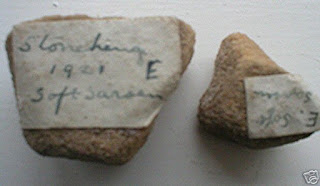Distribution of rock types in the Stonehenge Layer -- or rather, in that part of the Stonehenge Layer recently investigated. There is an extensive area still not studied -- and there is no knowing what might pop up during future investigations.......
One of my moles has sent me some info from a lecture which has already been presented twice (I think) and which will be given again within the next fortnight by one of the key geologists involved. Since all of this is already in the public domain, I don't suppose I am breaching any confidences by putting some of it onto the blog.
The summary of recent research involves the following:
1. There are 31 dolerite orthostats, of which 14 have been sampled in 1991 and 2008. Some are standing stones and some are stumps. Some are spotted and some are unspotted. (I am a bit mystified as to why the unspotted dolerites do not appear on the diagrams above -- stones 45 and 62 are made of unspotted dolerite.)
2. There are five crystal vitric ash flow tuffs represented in the orthostat collection. (Stones 40, 48, 46, 38, 52c. (Four distinct types?) There is not much debris to match these in the Stonehenge debitage, but similar fragments are found in the great cursus field. Research is ongoing, but they may come from the Preseli area.
3. There are four volcanic ashes -- stumps 32c, 33e, 33f, 41d.
4. There is one calcareous volcanic ash stump -- number 40c
5. There are 2 micaceous sandstone stumps -- numbered 40g and 42c. (More info is eagerly awaited on these......) There are also lumps of Lower Palaeozoic sandstone scatterd about in the debitage -- the largest lump weighing c 8.5 kgs. From SW Wales?
6. There is another calcareous sandstone -- the Altar Stone (stone 80). sampled more than a hundred years ago, but not since. Probably from the Senni Beds of Carmarthenshire or Powys? (Not from Milford Haven) Interestingly, no debitage has been recognized in recent digs from this stone or from anything like it.
7. In the debitage there are lots of fragments of volcanics with sub-planar cleavage -- matching the Rhosyfelin rocks? The "rhyolite with fabric" is not all the same -- but most appears to be from the Pont Saeson area. There are NO matching orthostats.
8. There are also some basic tuffs in the collection of fragments from the debitage -- two lithologically different types. From the Fishguard Volcanics?
9. Other lithics in the stone collections from the debitage -- some stones are adventitious / introduced / modern, but some (eg haematite, greensand, Mesozoic sandstones and gabbros appear genuine, and need further research.
10. In the course of the recent geological research, 6,368 rock samples have been examined and classified -- and organized by archaeological context. the total weight of samples thus far is in excess of 70 kg. Most fragments are very small, weighing on average about 11 grams.
11. Almost half of the material in the debitage is sarsen -- I suppose we should not be surprised by that, but it would be good to know how many types of sarsen there are, and where they came from.....
12. This recent research matches pretty well with what I said in my post dated 3 December 2011:
http://brian-mountainman.blogspot.co.uk/2011/12/bluestone-rock-types.html
I reckoned then that there are about 30 different rock types represented in the "bluestone assemblage" -- and unlike Rob, I give significance to the small bits as well as the orthostats, since I am interested in glacial and other processes and want to know where they came from and how they got here.


































.jpg)



